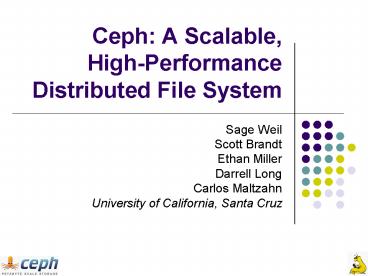Ceph: A Scalable, High-Performance Distributed File System - PowerPoint PPT Presentation
Title:
Ceph: A Scalable, High-Performance Distributed File System
Description:
... of commits to disk. Atomic compound data ... EBOFS writes saturate disk for request sizes over 32k ... Manage replication, failure detection, and recovery ... – PowerPoint PPT presentation
Number of Views:1342
Avg rating:3.0/5.0
Title: Ceph: A Scalable, High-Performance Distributed File System
1
Ceph A Scalable, High-Performance Distributed
File System
- Sage Weil
- Scott Brandt
- Ethan Miller
- Darrell Long
- Carlos Maltzahn
- University of California, Santa Cruz
2
Project Goal
- Reliable, high-performance distributed file
system with excellent scalability - Petabytes to exabytes, multi-terabyte files,
billions of files - Tens or hundreds of thousands of clients
simultaneously accessing same files or
directories - POSIX interface
- Storage systems have long promised scalability,
but have failed to deliver - Continued reliance on traditional file systems
principles - Inode tables
- Block (or object) list allocation metadata
- Passive storage devices
3
CephKey Design Principles
- Maximal separation of data and metadata
- Object-based storage
- Independent metadata management
- CRUSH data distribution function
- Intelligent disks
- Reliable Autonomic Distributed Object Store
- Dynamic metadata management
- Adaptive and scalable
4
Outline
- Maximal separation of data and metadata
- Object-based storage
- Independent metadata management
- CRUSH data distribution function
- Intelligent disks
- Reliable Autonomic Distributed Object Store
- Dynamic metadata management
- Adaptive and scalable
5
Object-based StorageParadigm
Traditional Storage
Object-based Storage
Applications
Applications
File System
File System
Object Interface
Storage component
Logical Block Interface
Hard Drive
Object-based Storage Device (OSD)
6
CephDecoupled Data and Metadata
Applications
File System
Client
Metadata Manager
7
CRUSHSimplifying Metadata
- Conventionally
- Directory contents (filenames)
- File inodes
- Ownership, permissions
- File size
- Block list
- CRUSH
- Small map completely specifies data
distribution - Function calculable everywhere used to locate
objects - Eliminates allocation lists
- Inodes collapse back into small, almost
fixed-sized structures - Embed inodes into directories that contain them
- No more large, cumbersome inode tables
8
Outline
- Maximal separation of data and metadata
- Object-based storage
- Independent metadata management
- CRUSH data distribution function
- Intelligent disks
- Reliable Autonomic Distributed Object Store
- Dynamic metadata management
- Adaptive and scalable
9
RADOSReliable AutonomicDistributed Object Store
- Ceph OSDs are intelligent
- Conventional drives only respond to commands
- OSDs communicate and collaborate with their peers
- CRUSH allows us to delegate
- data replication
- failure detection
- failure recovery
- data migration
- OSDs collectively form a single logical object
store - Reliable
- Self-managing (autonomic)
- Distributed
- RADOS manages peer and client interaction
- EBOFS manages local object storage
RADOS
RADOS
EBOFS
EBOFS
10
RADOS Scalability
- Failure detection and recovery are distributed
- Centralized monitors used only to update map
- Maps updates are propagated by OSDs themselves
- No monitor broadcast necessary
- Identical recovery procedure used to respond to
all map updates - OSD failure
- Cluster expansion
- OSDs always collaborate to realize the newly
specified data distribution
11
EBOFSLow-level object storage
- Extent and B-tree-based Object File System
- Non-standard interface and semantics
- Asynchronous notification of commits to disk
- Atomic compound datametadata updates
- Extensive use of copy-on-write
- Revert to consistent state after failure
- User-space implementation
- We define our own interfacenot limited by
ill-suited kernel file system interface - Avoid Linux VFS, page cachedesigned under
different usage assumptions
RADOS
EBOFS
12
OSD PerformanceEBOFS vs ext3, ReiserFSv3, XFS
- EBOFS writes saturate disk for request sizes over
32k - Reads perform significantly better for large
write sizes
13
Outline
- Maximal separation of data and metadata
- Object-based storage
- Independent metadata management
- CRUSH data distribution function
- Intelligent disks
- Reliable Autonomic Distributed Object Store
- Dynamic metadata management
- Adaptive and scalable
14
MetadataTraditional Partitioning
Coarse partition
Fine partition
- Static Subtree Partitioning
- Portions of file hierarchy are statically
assigned to MDS nodes - (NFS, AFS, etc.)
- File Hashing
- Metadata distributed based on hash of full path
(or inode )
- Directory Hashing
- Hash on directory portion of path only
- Coarse distribution (static subtree partitioning)
- hierarchical partition preserves locality
- high management overhead distribution becomes
imbalanced as file system, workload change - Finer distribution (hash-based partitioning)
- probabilistically less vulnerable to hot spots,
workload change - destroys locality (ignores underlying
hierarchical structure)
15
Dynamic Subtree Partitioning
Root
MDS 0
MDS 1
MDS 2
MDS 3
MDS 4
Busy directory hashed across many MDSs
- Scalability
- Arbitrarily partitioned metadata
- Adaptability
- Cope with workload changes over time, and hot
spots
16
Metadata Scalability
- Up to 128 MDS nodes, and 250,000 metadata
ops/second - I/O rates of potentially many terabytes/second
- Filesystems containing many petabytes (or
exabytes?) of data
17
Conclusions
- Decoupled metadata improves scalability
- Eliminating allocation lists makes metadata
simple - MDS stays out of I/O path
- Intelligent OSDs
- Manage replication, failure detection, and
recovery - CRUSH distribution function makes it possible
- Global knowledge of complete data distribution
- Data locations calculated when needed
- Dynamic metadata management
- Preserve locality, improve performance
- Adapt to varying workloads, hot spots
- Scale
- High-performance and reliability with excellent
scalability!
18
Ongoing and Future Work
- Completion of prototype
- MDS failure recovery
- Scalable security architecture Leung, StorageSS
06 - Quality of service
- Time travel (snapshots)
- RADOS improvements
- Dynamic replication of objects based on workload
- Reliability mechanisms scrubbing, etc.
19
Thanks!
- http//ceph.sourceforge.net/
- Support from
- Lawrence Livermore, Los Alamos, and Sandia
- National Laboratories




























